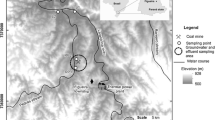Abstract
The distribution of radioactive pollutants, such as222Rn, U, Th and226Ra in the air, surface waters, soils and crops around the Lincang uranium mine, Yunnan Province, China, is studied. The mechanical, geochemical and biogeochemical processes responsible for the transport and fate of the radioactive elements are discussed based on the monitoring data. The pollutants concentrations of effluents from the mine tunnels were dependent on pH and which were controlled by biochemical oxidation of sulfide in the ore/host rocks. Radon anomalies in air reached 4 km from the tailings pile depending on radon release from the site, topography and climate.238U and226Ra abnormities in stream sediments and soil were 40—90 cm deep and 790—800 m away downstream. Anomalies of radioactive contaminants of surface watercourses extended 7.5—13 km from the discharge of effluents of the site mainly depending on mechanical and chemical processes. There were about 2.86 ha rice fields and 1.59 km stream sediments contaminated. Erosion of tailings and mining debris with little or no containment or control accelerated the contamination processes.
Similar content being viewed by others
References
Gillmore, G. K., Grattan, J., Pyatt, F. B. et al., Radon, water and abandoned metalliferous mines in the UK: Environmental and Human Health Implications, in Uranium in the Aquatic Environment, Proceedings of the International Conference Uranium Mining and Hydrogeology III and the International Mine Water Association Symposium (eds. Merkel, B. J., Planer-Friedrich, B., Wolkersdorfer, C.), Berlin: Springer, 2002, 65–76.
GB/T 16146-1995, Standards for Controlling Radon Concentration in Dwellings (in Chinese).
Kinze, M., Dose limits and maximum concentration limits (MCL’s) for radionuclides—Implication on remediation of uranium mining and milling facilities in Saxony Germany, in Uranium in the Aquatic Environment, Proceedings of the International Conference Uranium Mining and Hydrogeology III and the International Mine Water Association Symposium (eds. Merkel, B. J., Planer-Friedrich, B., Wolkersdorfer, C.), Berlin: Springer, 2002, 1–7.
Xu, L. C., Wang, Y. X., Environmental issues and remedial actions of the abandoned Lincang uranium mine in China, in Uranium in the Aquatic Environment, Proceedings of the International Conference Uranium Mining and Hydrogeology III and the International Mine Water Association Symposium (eds. Merkel, B. J., Planer-Friedrich, B., Wolkersdorfer, C.), Berlin: Springer, 2002, 709–718.
International Atomic Energy Agency, Decommissioning of Facilities for Mining and Milling of Radioactive Ores and Closeout of Residues, Technical Report Series No. 362, Vienna: IAEA, 1994, 70.
OECD/NEA (Nuclear Energy Agency), Environment Activities in Uranium Mining and Milling, A Joint NEA/IAEA Report, Paris: Pubie en Francais Sous le Titre, 1999, 23–26.
Xu, L. C, Dai, X., Tan, T. et al., Environment Impact Report on Environmental Treatment Engineering of Decommissioning Lincang Uranium Mine (Feasibility studies stages) (in Chinese), 1999.
Zhang Zhihui, Measurement Methods of Radon and Its Daughters in Atmosphere (in Chinese), Beijing: Atomic Energy Press, 1994, 40–46.
Li Yuxian, Investigation of Environmental Natural Radiological Level in Yunnan Province (in Chinese), Kunming: Yunnan Science and Technology Press, 1991.
OECD/NEA (Nuclear Energy Agency), Environment Remediation of Uranium Production Facilities, A Joint NEA/IAEA Report, Paris: Pubie en Francais Sous le Titre, 1999, 57–58.
International Atomic Energy Agency, The Behaviour of Radium in Waterway and Aquifers, IAEA-TECDOC-301, Vienna: IAEA, 1984, 163.
Zhou Qunying, Gao Tingyao, Microbiology of Environmental Engineering (in Chinese), Beijing: Higher Education Press, 2000, 215.
Popescu-Tecuci, M., Georgescu, D., Filip, G., A study of the interference between radioactive ore dumps and vegetation aiming at the limitation of the contamination process in uranium mining areas, in Engineering Geology and the Environ- ment (eds. Marinos, Koukis, Tsiambaos, et al.), Rotterdam: Balkema, 1997, 2097–2101.
International Atomic Energy Agency, Decommissioning of Facilities for Mining and Milling of Radioactive Ores and Closeout of Residues, Technical Report Series No. 362, Vienna: IAEA, 1994, 9–11.
Author information
Authors and Affiliations
Corresponding author
Rights and permissions
About this article
Cite this article
Xu, L., Wang, Y., LÜ, J. et al. Radioactive contamination of the environment as a result of uranium production: a case study at the abandoned Lincang uranium mine, Yunnan Province, China. Sc. China Ser. B-Chem. 45 (Suppl 1), 11–19 (2002). https://doi.org/10.1007/BF02932202
Received:
Issue Date:
DOI: https://doi.org/10.1007/BF02932202




